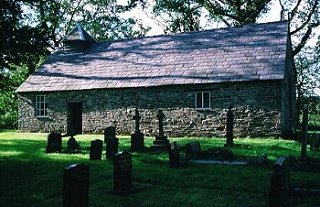|
Summary
A simple single-celled church
dedicated to St Michael, it is set in an irregularly shaped
churchyard. Little is known of the history, and there is nothing
architecturally that stylistically pre-dates the late 17thC. The
only pre-Reformation feature is the font.
Simple windows of post-medieval date set in walls
that have largely been rebuilt, though some original, but undated
fabric may survive.
Parts of the following description are quoted from
the 1979 publication The Buildings of Wales: Powys
by Richard Haslam
History
Little is known of the early history, but it was a
chapel of ease to the mother church of Nantmel until 1859, and had
no rights of burial or baptism until after 1818.
It was reportedly in a dilapidated condition in
1689 and in poor repair in 1812. The walls were partly rebuilt
c.1812, but Williams, in 1818, recorded that "the church is
dedicated to St Michael, whose memory is little honoured in the
meanness of its structure, and in its total want of those
appendages of accommodation generally found in places set apart
for religious worship". It has also been stated that the pews
and three-decker pulpit were brought here from another, unnamed,
church in the early part of the last century.
In 1851 it had 20 free and 50 other seats, with an
average congregation of 27. An account at this time (in Davies
1905) recorded that a large part of the south wall had been
re-built, together with the upper portions of the east and west
walls; and in the latter there were signs of two successive
re-builds. A fleur-de-lys of iron, set upright in the ridge of the
roof, was recorded where the chancel was supposed to have begun.
The churchyard contained only two or three sod-covered graves.
An east window was put in after an appeal by the
curate, Thomas Price, about 1854. Other phases of reconstruction
have been mooted. The extent of rebuilding is not known but on the
basis of limewash traces, it is possible that north wall not
altered as much as others.
The church was restored in 1956 by the Pilgrim
Trust, with further work in 1994.
FURTHER DETAILS REQUIRED PLEASE
|


